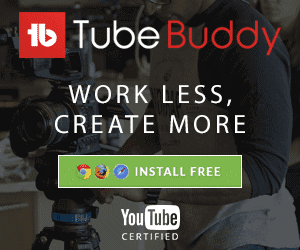YouTube is a unique platform that falls into both social media and search engine categories.
This is one of the reasons why it still continues to grow in popularity, being the second most popular search engine and second most popular “social” platform behind only Facebook in terms of monthly users.
Ranking on YouTube is one of the keys to success on the platform and YouTube SEO is a fundamental part of reaching the top of search results.
In this article, we’re going to look at how to optimize your videos to rank higher in the search results.
What YouTube SEO cannot solve
Things like:
- Bad content
- Poor keyword research
- Horrible audio
- Violence, nudity, and other things that go against YouTube Community guidelines
If you’re serious about YouTube SEO and ranking your videos, these 4 aspects are really basic principles that you should and can be avoided easily.
Keyword research isn’t as difficult as it may sound, peruse similar content, use Google’s keyword planner, and YouTube’s search bar to get an idea of what people are looking for in your niche.
Audio is often overlooked and one of the biggest click-away factors for viewers. There is no excuse for poor audio when you can get a lapel mic for less than $10 on Amazon.
Do I even have to mention why breaking the terms of service is a bad idea?
Lastly, how do you know if you’re making good content? Ask yourself this: Why and for whom am I making this? If you can’t come up with a good answer, bin it and move on to your next idea.
For many people, that could be the end of the line. I’ve made some great content; YouTube will cover the rest.
Wrong.
YouTube may have a smart way of ranking videos, but it still needs the creator’s help.
Let’s take a look at how you can help guide YouTube to rank your videos effectively.
YouTube SEO: 5 steps to optimize your videos today

Step 1: Optimize your video title
Your titles and thumbnails are the first things that potential viewers see when scrolling their feeds or search results. Your video title should include your selected keywords worked into a proper sentence.
Avoid keyword stuffing and click-baiting. Once viewers see past the ruse, you’ll receive a ton of negative SEO.
Try formulating long-tail keywords to rank for more terms & keep your titles longer than 5 words.
Keep your video titles below 70 characters, as anything more will be truncated in most search results.
*Long-tail keywords are phrases that people search for.
Keep your keyword at the beginning of your title if you can, this tends to give an extra YouTube SEO boost.
I.e., For the keyword “YouTube SEO,” the title “YouTube SEO: How to rank your videos in 2024” would be a better option than “How to improve your YouTube SEO in 2024”.
Step 2: Optimize your video description
Your video description is arguably even more important than your title.
Ok, no argument; they’re both VERY important in helping YouTube understand your video.
If YouTube understands your video correctly, you’ll have a much higher chance of ranking in search and showing up in the suggested videos sidebar.
You can have up to 5000 characters in your description, but you don’t need to fill it out.
I recommend a minimum of 300 words and including your keyword in the first 25 words or sentences of your description.
Additionally, scatter your keywords throughout your description another two or three times using proper sentences related to your video.
Once again, avoid keyword stuffing. This will keep you from looking spammy and help YouTube understand where exactly your video belongs.

Step 3: Say your keywords in the video
YouTube automatically transcribes your entire video, and they normally do a pretty good job at it. When YouTube hears you mentioning your keyword, it gives you some extra plus points to your YouTube SEO ranking.
By having your keywords as some of the first words you say, you’re telling YouTube that this is a very important keyword in your video. So, mention it as soon as possible and then scatter it 2 or 3 times throughout the rest of your video.
Keep it natural, though… Don’t edit in a cutscene of you mentioning your keyword three times while spinning around in front of a mirror.
Step 4: Create and use YouTube playlists
Playlists are awesome; not only do they automatically play every video included in them… which can lead to thousands of extra views… They also show up in search results.
Remember to include your keywords in the name of your playlist. You can also include similar videos of your own or even from other creators if you haven’t gotten enough content on the subject yet.
Step 5: Include video meta tags
YouTube tags are a great way to appear in the related videos sidebar and help with your on-page YouTube SEO.
You can include up to 500 characters in your tags, and you might as well fill it up with relevant keywords… For example, if you want to stuff keywords, now’s your chance!
But hold up! There’s some method to the madness of video tags, and you may want to think about which tags will make up your 500 characters.
Firstly, include the main keywords you’re looking to rank for.
Next, include some keyword variations and the full long-tail keywords you’ve researched.
If you still have some characters leftover, include relevant terms from your niche to close things out.
Pro tip: Check out what tags your competitors and similar videos are using and include them in your tags. This will improve the chances of your video appearing as a suggested video when someone watches one of theirs.
Use TubeBuddy to help optimize your videos
TubeBuddy is a browser extension that packs a lot of features into their paid plans but is also very powerful, even if you only use the free version.
With the free browser extension, you can:
- See what tags your competitors are using
- Use the keyword explorer to find good keywords to target
- Get automatic suggestions on what tags to include
- See what channel tags your competitors have
- Analyze what languages your audience speaks
- See the best time to publish videos
The paid plans take this up a notch with things like:
- A/B Testing
- Bulk description updates
- Bulk card updates
- Automatic translations
- Full keyword explorer access
- And more
Download the free TubeBuddy extension here.
Le Grand Finale
When it comes to growing on YouTube, there are many things you can do to help the YouTube algorithm find your videos and show them to the right people.
With good planning and execution, you can also rank your videos at the top of YouTube search results.
To grow your channel further, you need to pay attention to other aspects of your channel and your audience in particular. Things like your thumbnail, what interests your audience, what are their pain points, etc. are all important aspects that you need to focus on in order to harness YouTube’s social aspect and elevate your growth.

